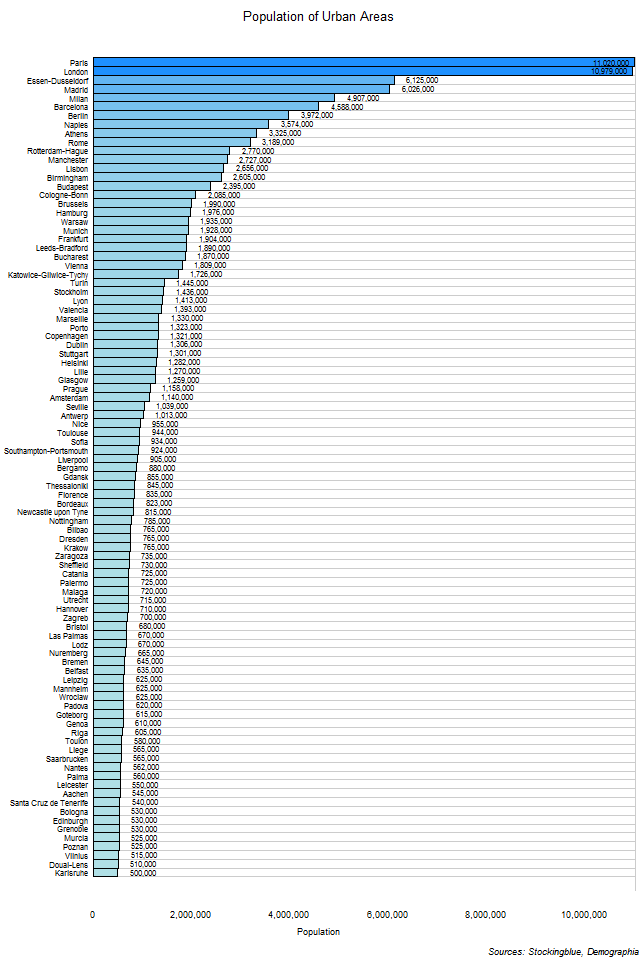
The chart above shows the population of each urban area with a population over 500,000. The urban areas have been normalized so as to avoid any inconsistencies with how cities and their metropolitan areas are defined by their governments. Each urban area has similar characteristics making this the definitive method with which to compare cities across various countries. Paris has the largest population in the EU.
Findings
- The difference between the urban area with the greatest population, Paris, and the urban area with the least, Karlsruhe, is 10,520,000 people.
- Paris has 22.04 times the population that Karlsruhe does.
- The median population of urban areas with a minimum population of 500,000 in the 28 EU states is 880,000 people and the mean 1,568,569.89 people.
Caveats
- Data is from 2020.
- The methodology for how these urban areas have been defined can be found in the source link below. As of this writing this is the most reliable way to compare urban areas throughout the world.
- All figures are rounded to the nearest whole.
Details
Only 22 of the 28 EU states have urban areas with at least 500,000 people. Of these, Germany has 16; the United Kingdom has 14; France, Italy, and Spain each have 11; Poland has seven; Belgium and the Netherlands each have three; Greece, Portugal, and Sweden each have two; and Austria, Bulgaria, Croatia, Czechia, Denmark, Finland, Hungary, Ireland, Latvia, Lithuania, and Romania each have one.
Paris makes up one-fifteenth of the total population of EU urban areas with over 500,000 inhabitants at 7.55%. It, along with London and Essen-Dusseldorf make up just under one-fifth of the total population of EU urban areas with over 500,000 inhabitants at 19.28%. Adding in Madrid and Milan brings it up to over one-quarter at 26.77%.
Of the 93 urban areas with a population over 500,000, 43 have a population of over 1 million. Four have a population of more than 5 million, and two have a population of more than 10 million.
Hungary has the largest mean population in its urban areas over 500,000 people with a mean of 2,395,000 people distributed among its one urban area. Greece follows with 2,085,000 people among its two urban areas. They are followed by Portugal (1,989,500), Romania (1,870,000), the United Kingdom (1,858,143), France (1,812,455), Austria (1,809,000), Italy (1,640,000), Spain (1,596,455), Germany (1,558,500), the Netherlands (1,541,667), Denmark (1,321,000), Ireland (1,306,000), Finland (1,282,000), Belgium (1,189,333), Czechia (1,158,000), Sweden (1,025,500), Poland (1,014,429), Bulgaria (934,000), Croatia (700,000), Latvia (605,000), and Lithuania (515,000).
Hungary has the largest median population in its urban areas over 500,000 people with a median of 2,395,000 people distributed among its one urban area. Greece follows with 2,085,000 people among its two urban areas. They are followed by Portugal (1,989,500), Romania (1,870,000), Austria (1,809,000), Denmark (1,321,000), Ireland (1,306,000), Finland (1,282,000), Czechia (1,158,000), the Netherlands (1,140,000), Sweden (1,025,500), Belgium (1,013,000), France (944,000), Bulgaria (934,000), the United Kingdom (860,000), Italy (835,000), Poland (765,000), Germany (737,500), Spain (735,000), Croatia (700,000), Latvia (605,000), and Lithuania (515,000).
Cyprus, Estonia, Luxembourg, Malta, Slovakia, and Slovenia do not have any urban areas with a population over 500,000 inhabitants.
Data
| State | Population (Cities over 500,000) | Mean Population | Median Population | Number of Large Urban Areas |
|---|---|---|---|---|
| Austria | 1,809,000 | 1,809,000 | 1,809,000 | 1 |
| Belgium | 3,568,000 | 1,189,333 | 1,013,000 | 3 |
| Bulgaria | 934,000 | 934,000 | 934,000 | 1 |
| Croatia | 700,000 | 700,000 | 700,000 | 1 |
| Czechia | 1,158,000 | 1,158,000 | 1,158,000 | 1 |
| Denmark | 1,321,000 | 1,321,000 | 1,321,000 | 1 |
| Finland | 1,282,000 | 1,282,000 | 1,282,000 | 1 |
| France | 19,937,000 | 1,812,455 | 944,000 | 11 |
| Germany | 24,936,000 | 1,558,500 | 737,500 | 16 |
| Greece | 4,170,000 | 2,085,000 | 2,085,000 | 2 |
| Hungary | 2,395,000 | 2,395,000 | 2,395,000 | 1 |
| Ireland | 1,306,000 | 1,306,000 | 1,306,000 | 1 |
| Italy | 18,040,000 | 1,640,000 | 835,000 | 11 |
| Latvia | 605,000 | 605,000 | 605,000 | 1 |
| Lithuania | 515,000 | 515,000 | 515,000 | 1 |
| Netherlands | 4,625,000 | 1,541,667 | 1,140,000 | 3 |
| Poland | 7,101,000 | 1,014,429 | 765,000 | 7 |
| Portugal | 3,979,000 | 1,989,500 | 1,989,500 | 2 |
| Romania | 1,870,000 | 1,870,000 | 1,870,000 | 1 |
| Spain | 17,561,000 | 1,596,455 | 735,000 | 11 |
| Sweden | 2,051,000 | 1,025,500 | 1,025,500 | 2 |
| United Kingdom | 26,014,000 | 1,858,143 | 860,000 | 14 |
Sources
Demographia. 2021. "Demographia World Urban Areas: 16th Annual Edition." Accessed March 9, 2021. http://demographia.com/db-worldua.pdf.